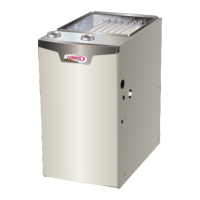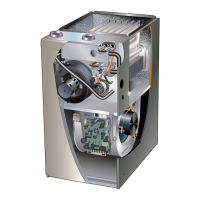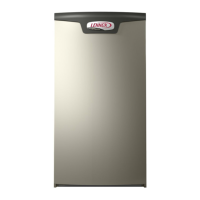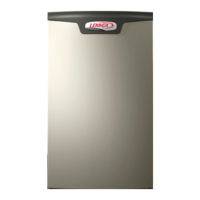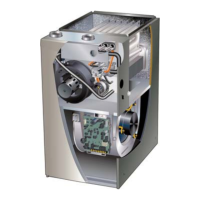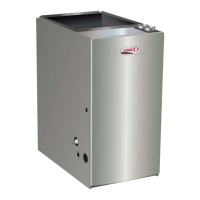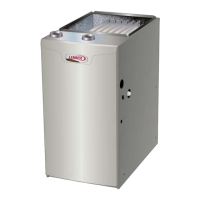Page 42
Vent Calibration
The vent calibration sequence establishes furnace oper-
ating parameters in a specic installation. The integrat-
ed control runs the calibration and may be repeated as
necessary to maintain proper furnace operation. Prior to
calibration, all duct work (and returns) vent pipe and con-
densate trap (primed) must be connected.
If calibration is successful the data is stored in memory
and will be used to determine furnace operation and main-
tain parameters during heat call. If calibration is not suc-
cessful, the integrated control will proceed to a 5 minute
delay and signal the appropriate code. After the 5 minute
delay the calibration will be repeated 4 more times with a
5 minute delay in between. If still unsuccessful after the
4 trials (total 5) the integrated control will go into a 1 hour
soft lockout.
Calibration may be initiated by:
• Initial call for heat
• Cycling main power o / on and then call for heat
• Venting conditions change (aecting high and low
pressure switch operation)
• Ramp down low re switch check failed (calibration
will follow next call for heat)
• The service technician (by pressing the push but-
ton found on the integrated control until the control
cycles through to “Field Test Mode”)
The integrated control will do the following during calibra-
tion:
1 - Verify both low pressure switch and high pressure
switch are open. If either are closed log error and
end calibration.
2 - Start inducer at a predetermined low RPM (1600).
Wait 7.5 seconds.
3 - Check low pressure switch, if open, increase RPM
by 250, wait 5 seconds. Repeat this step until low
pressure switch is closed.
4 - Decrease RPM by 50, wait 5 seconds and look for
the low pressure switch to open. Repeat this step
until it is open.
5 - Keep this RPM as RPM1.
6 - Increase RPM by 1250. Wait 5 seconds.
7 - Check high pressure switch, if open, increase RPM
by 250, wait 5 seconds. Repeat this step until high
pressure switch is closed.
8 - Decrease RPM by 50, check after 5 seconds.
Repeat this step until switch is open.
9 - Keep this RPM as RPM2.
10 - Calibration complete.
NOTE - If after a successful calibration and a heat call is
present the integrated control will by-pass the prepurge
state and go straight into ignitor warm up
After calibration, the integrated control stores the RPM1
and RPM2 values. The low re (35%) and high re (100%)
RPM points are calculated by adding margin values to the
RPM1 and RPM2 values.
The integrated control also initiates a low re switch check
at the end of a normal heating cycle described below. If
this check fails the pressure switch calibration will follow
on the next call for heat.
1 - The inducer runs 15 seconds at the last ring rate
before the heat call ended.
2 - Inducer runs at 35% ring rate RPM (RPM1 + low
pressure switch open RPM margin value).
3 - If low pressure switch is open, set ag for calibration
on next call for heat. Turn inducer o until next call
for heat.
4 - If low pressure switch is closed move inducer speed
to RPM1. Allow 5 seconds for stabilization.
5 - If low pressure switch opens turn o inducer. No
further action.
6 - If low pressure switch is still closed, decrease
inducer speed 1/2 of the low pressure switch open
RPM margin. Allow 5 seconds to stabilize.
7 - If low pressure switch is open turn o inducer. No
further action.
8 - If low pressure switch is still closed, set ag for
calibration on next call for heat and turn o inducer.
Measuring pressure dierential (FIGURE 18)
Checks of pressure dierential can aid in troubleshooting.
Lennox provides a kit (10L34) if necessary. When measur-
ing the pressure dierential, readings should be taken at
the pressure switch. Lack of dierential usually indicates
problems in the intake or exhaust piping, but may indicate
problems in the heat exchanger, condensing coil, header
boxes, combustion inducer or other components.
The dierential pressure is the dierence in pressure
measured across the cold end header box orice.
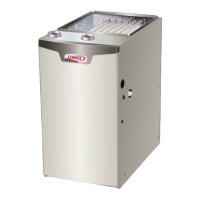
